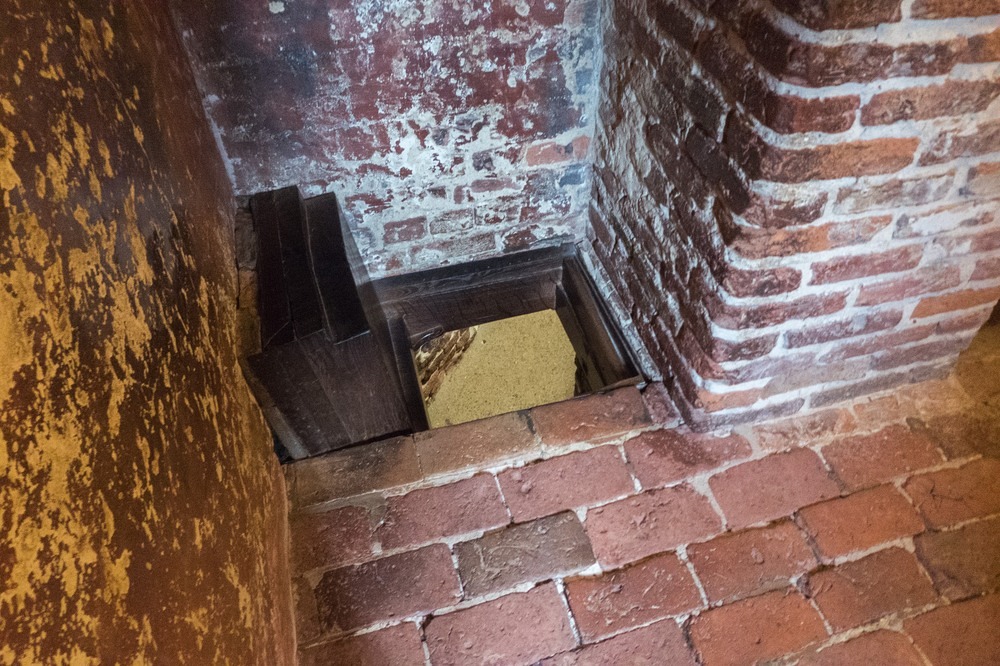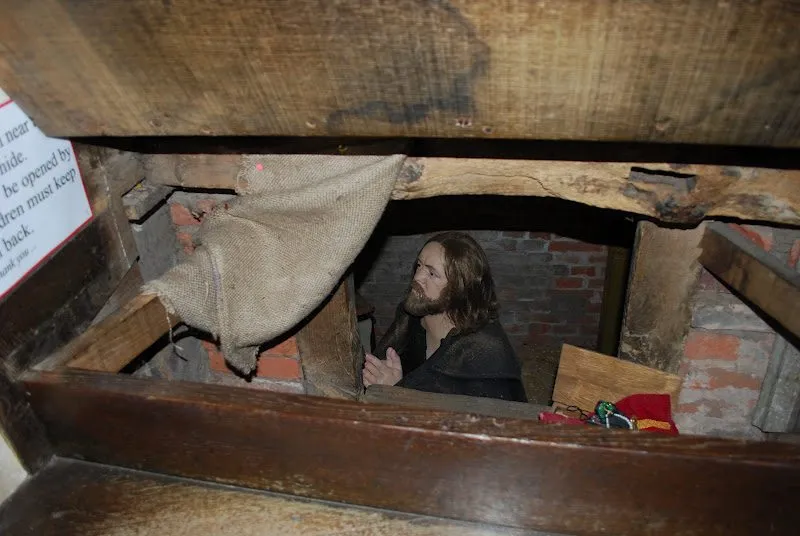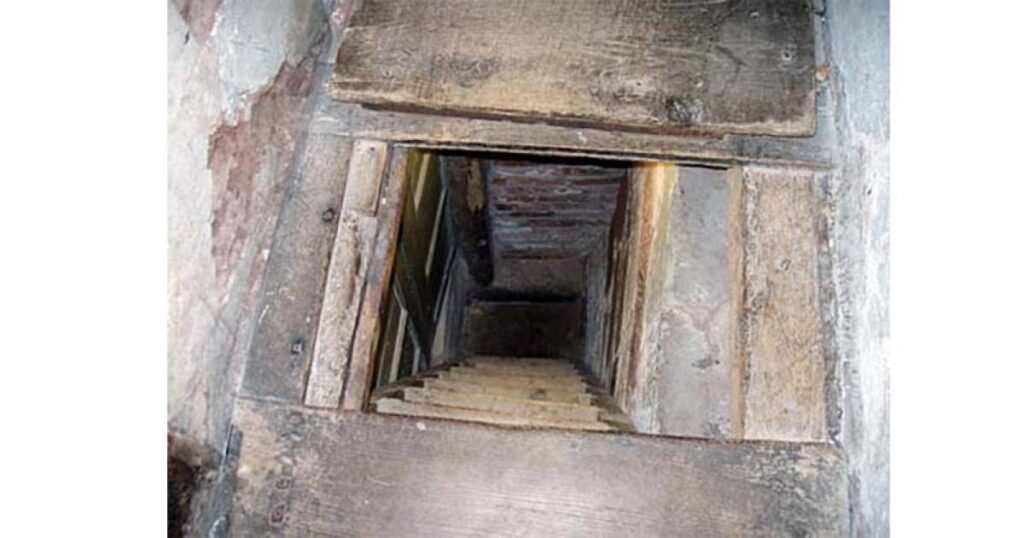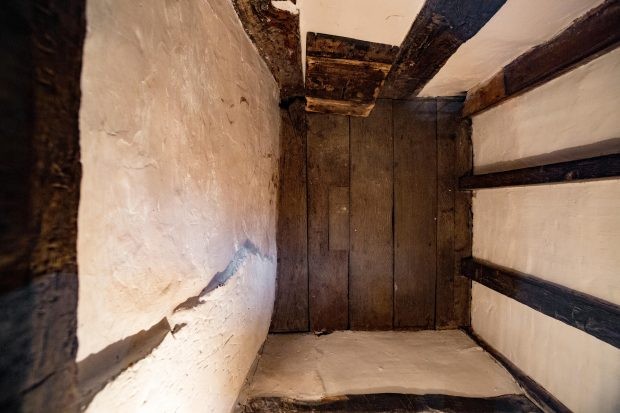“Secrets in the Walls: The Deadly History of England’s Priest Holes”

During one of the most tumultuous periods in English history—the Reformation and the Elizabethan era—a deadly game of hide and seek unfolded behind the walls of country houses. This wasn’t a children’s game, but a brutal clash between religion and politics. The players? Catholic priests hiding for their lives and the “priest hunters” determined to capture them.
At the heart of this dangerous game were priest holes—ingenious, hidden chambers designed to conceal Catholic clergymen from the prying eyes of Elizabethan authorities. These secret spaces, scattered throughout manor houses in England, were often the only thing standing between a man of faith and a torturous death.
This article explores the origins, construction, use, and legacy of priest holes—and the grim reality of the men who used them and those who sought to expose them.
🕰️ Historical Context: England’s Religious Upheaval
The story of priest holes begins in the 16th century, following the split between the Roman Catholic Church and the Church of England initiated by King Henry VIII. Under Queen Mary I (a Catholic), Protestantism was persecuted. But the tide turned dramatically under Queen Elizabeth I (reigned 1558–1603), a Protestant monarch who viewed Catholicism as a threat to national security.
In 1570, Pope Pius V excommunicated Elizabeth, declaring her a heretic and urging her overthrow. From then on, Catholicism was not just a religion—it was treason. Practicing Catholicism, harboring a priest, or even attending Mass could result in fines, imprisonment, torture, or execution.
🏚️ What Were Priest Holes?
Priest holes were ingeniously concealed spaces built within the walls, floors, chimneys, staircases, or attics of Catholic-owned homes. Their purpose was to hide Jesuit and missionary priests, who secretly traveled across England to minister to Catholic families.
Features of priest holes:
- Hidden access points behind wood panels, fireplaces, under floorboards, or inside chimneys.
- Often designed to include air vents and space for minimal movement, though many were incredibly claustrophobic.
- In some cases, false priest holes were built to throw searchers off the trail.
- Designed to withstand days-long inspections and raids.
The most famous designer of priest holes was Nicholas Owen, a Jesuit lay brother and master carpenter. He devoted his life to building safe hiding places, often alone, and with such secrecy that many of his creations are still being discovered today.


👤 Nicholas Owen: The Secret Carpenter
Nicholas Owen (c. 1562–1606) is the unsung hero of this underground world. A skilled builder and devout Catholic, he joined the Jesuit mission in England, risking everything to protect priests from capture.
He worked for nearly 20 years constructing priest holes so cleverly hidden that even today, they escape detection. He was arrested multiple times, tortured, and eventually died in the Tower of London after being brutally interrogated—refusing to give up the locations of the priest holes he had created.
Owen was later canonized as a Catholic saint and martyr in 1970.
🔍 The Priest Hunters
In opposition stood the “priest hunters” or pursuivants—officials and informers who specialized in rooting out Catholic priests and their protectors. They would:
- Conduct raids on suspected Catholic households, often without warning.
- Tear apart furniture, walls, ceilings, and even dig up floors in search of hidden chambers.
- Use dogs, thermal cues (like steam), and noise to detect hidden occupants.
- Wait outside the house for days, hoping to catch hidden priests attempting to flee.
If a priest was found, he could expect imprisonment, torture, and execution—often by hanging, drawing, and quartering. Those who harbored priests could suffer similarly.
🏰 Notable Priest Hole Locations
Many stately homes across England were safe havens for priests and still contain examples of these architectural secrets:
- Baddesley Clinton (Warwickshire): Has multiple priest holes hidden near the moat and inside chimneys.
- Harvington Hall (Worcestershire): Contains the largest known number of priest holes in one house, many attributed to Nicholas Owen.
- Oxburgh Hall (Norfolk): Features a well-preserved hiding hole beneath a latrine.
- Huddington Court and Coughton Court: Other famous centers of Catholic resistance and priest concealment.
⛪ The Role of Catholic Recusants
Catholic families who refused to attend Anglican services were called recusants. These families often risked everything to preserve their faith:
- They funded and hosted traveling priests.
- Constructed hidden chapels and secret passageways.
- Passed down coded messages and used spycraft to avoid detection.
For them, hiding a priest was not just hospitality—it was an act of religious devotion and resistance.
⚰️ The Aftermath and Legacy
As the persecution of Catholics lessened in the 17th and 18th centuries, the need for priest holes declined. Yet many of these hiding places remain preserved today, offering haunting windows into a time of religious warfare.
Today, they are:
- Historical artifacts: Visitable at English Heritage sites and preserved manor homes.
- Symbols of religious resilience: A reminder of the costs of conscience and belief.
- Inspirations for fiction: Featured in novels, historical dramas, and even spy stories.
The ingenuity of the builders and the bravery of the priests and families involved are now honored, rather than condemned.

🧠 Conclusion: A Game of Faith, Fear, and Survival
The era of priest holes was a dangerous chapter in England’s religious history, where faith clashed violently with political power. In a society where praying the wrong way could mean death, believers relied on hidden craftsmanship, secrecy, and unshakable conviction.
In the dark silence of a priest hole, every breath might betray you. But for those involved, their silence was a statement of faith, and their survival was a victory over persecution. What remains today are more than hollow spaces behind walls—they are monuments to courage, ingenuity, and belief under fire.”Secrets in the Walls: The Deadly History of England’s Priest Holes”




